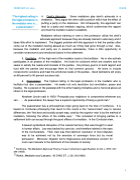FEBRUARY 28, 2019 INADR “The highest calling in the legal profession is the mediator who is ......... a peacemaker.” 4. Devil’s Advocate. Some mediators play devil’s advocate in a mediation. They argue the other side’s position which has the effect of putting a party on the defensive. Not infrequently, this approach can lead to a party and mediator arguing, which undermines the rapport and trust the mediator seeks to establish. Mediators without training or new to the profession utilize the devil’s advocate approach because they are already trained in advocacy and it takes little effort to implement. The biggest problem with this approach is that the parties often come out of the mediation feeling abused as much as if they had gone through a trial. Also, because the mediator and party are in essence adversaries, there is little opportunity to consider noneconomic and emotional factors in the settlement. 5. Facilitator. At the high end of the mediator scale is the facilitator. He or she actively participates in all phases of the mediation. He looks for solutions which are creative and he seeks to satisfy the needs and interests of the parties. His primary goal is to build rapport and trust with the parties and encourage them to fifind common ground. He looks to include noneconomic solutions and meet the emotional needs of the parties. Good facilitators will enjoy an 80 percent to 90 percent success rate. 6. Peacemaker. The highest calling in the legal profession is the mediator who is facilitator but also a peacemaker. He seeks not only resolution but conciliation, peace and healing. He is placed on the pedestal with the other healing ministries and is honored above all others in the legal profession. Abraham Lincoln said in 1850: “Persuade your neighbors to compromise whenever you can . . . . As peacemaker, the lawyer has a superior opportunity of being a good man.” The peacemaker has a philosophical origin going back to the time of Confucius. It is based on Confucian philosophy that resort to the courts is the “second best” way to resolve differences, the “fifirst best and socially proper way, used by the superior man is by the method of mediation, following the ethics of the middle way.” This consisted of bringing parties to a settlement both can accept through the good offifices of a mediator. In the Confucian view, A lawsuit symbolized disruption of the natural harmony that was thought to exist in human affairs. Law was backed by coercion, and therefore tainted in the eyes of the Confucianists. Their view was that optimum resolution of most disputes was to be achieved not by the exercise of sovereign force but by moral persuasion. Moreover, litigation led to litigiousness and shameless concern for one’s own interests to the detriment of the interests of society. 1 Northrope, The Mediation Approved Theory of Law in American Legal Realism, 44 VA. L. REV. 347, 349 (1958) 2 Riskin, Mediation and Lawyers, 43 OHIO ST. J. 29, 34 (1982) !4
